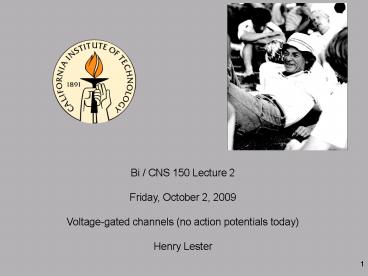Bi CNS 150 Lecture 2 - PowerPoint PPT Presentation
1 / 19
Title:
Bi CNS 150 Lecture 2
Description:
Voltage-gated channels (no action potentials today) ... Open flap. When the flap closes, the channel 'inactivates'. The flap may be linked to the 4th S4 domain. ... – PowerPoint PPT presentation
Number of Views:122
Avg rating:3.0/5.0
Title: Bi CNS 150 Lecture 2
1
Bi / CNS 150 Lecture 2 Friday, October 2,
2009 Voltage-gated channels (no action
potentials today) Henry Lester
2
The Bi / CNS 150 2008 Home Page
http//www.cns.caltech.edu/bi150/
Please note Henry Lesters office hours today
Fri (today) 2 PM Red Door
3
If you drop the course, or if you register
late, please email Shawna Frazier (in addition to
the Registrars cards). Also, if you want to
change sections, please email Shawna
4
From Lecture 1
K ions lose their waters of hydration and are
co-ordinated by backbone carbonyl groups when
they travel through a channel.
5
Major Roles for Ion Channels
6
The electric field across a biological membrane,
compared with other electric fields in the
modern world
1. A high-voltage transmission line 1 megavolt
106 V. The ceramic insulators have a length of
1 m. The field is 106 V/m.
2. A biological membrane The resting potential
the Nernst potential for K, -60 mV. The
membrane thickness is 3 nm 30 Å. The field is
(6 x 10-2 V) / (3 x 10-9 m) 2 x 107 V/m !!!
7
open channel conductor
8
1973
9
Intracellular recording with sharp glass
electrodes
- RC 10 ms
- too large!
10
A better way record the current from channels
directly?
Feynmans idea
11
A single voltage-gated Na channel
-20 mV
-80 mV
Dynamic range 10 ms to 20 min 108 2 pA to
100 nA 50,000 chans/cell
12
Press release for 1991 Nobel Prize in Physiology
or Medicine
http//www.nobel.se/medicine/laureates/1991/press.
html
13
Shaker, a well-studied voltage-gated K channel
Shaker, a Drosophila mutant first studied in
(the late) Seymour Benzers lab by graduate
students Lily Yuh-Nung Jan (now at UCSF) Gene
isolated simultaneously by L Y-N Jan lab by
Mark Tanouye (Benzer postdoc, then Caltech prof,
now at UC Berkeley).
14
The Hodgkin-Huxley formulation of a neuron
membrane
Today we emphasize H Hs description of
channel gating (although they never mentioned
channels, or measured a single channel) Channel
opening and closing rate constants are functions
of voltage--not of time The conformational
changes are Markov processes. The rate
constants depend instantaneously on the
voltage--not on the history of the
voltage. These same rate constants govern both
the macroscopic (summed) behavior and the
single-molecule behavior.
15
Demonstrating the Bezanilla model, 1
This channel is actually Shaker with inactivation
removed (Shaker-IR). Based on biochemistry,
electrophys, site-directed mutagenesis,
Xtallography, fluorescence. Two of 4 subunits.
Outside is always above (show membrane). Green
arrows K. C1 and C2 are closed states, A is
active open. 6 helices (S1-S6) P region,
total / subunit. Two green helices (S5, S6 P)
correspond to the entire Xtal structure on slide
4. First use manual opening. Channel opens when
all 4 subunits are A. Note the charges in S4
(5/subunit, but measurements give 13 total).
Alpha-helix with Lys, Arg every 3 rd
residue. Countercharges are in other
helices. Note the S4 charge movement, shots.
Where is the field, precisely? Yet unknown. Note
the hinge in S6, usually a glycine.
16
Demonstrating the Bezanilla model, 2
Read the explanation on the simulation. Show
plot. Voltage. Although we simulate
sequentially, the cell adds many channels in
parallel. Not an action potential this is a
voltage jump or voltage clamp
experiment. Describe shots (measure with
fluorescence, very approximately). I current.
Note three types of I. Describe gating current
(average I(gate) its waveform does not equal
the I(average). Show -50 mV (no openings), -30 mV
(delayed openings, delayed rectifier), 0. Note
tail current. Note I(gate).
17
Inactivation a property of all voltage-gated Na
channels and of Some voltage-gated K channels
http//nerve.bsd.uchicago.edu/Na_chan.htm
Site home
http//nerve.bsd.uchicago.edu/
- This model is 10 years older than the K
channel simulation. - Na channel has only one subunit, but it has 4
internal repeats - (its a pseudo-tetramer).
- The internal repeats resemble an individual K
subunit. The P region differs! - Orange balls are Na.
- Note that the single-channel current (balls
inside cell) requires two events - All 3 S4 must move up, in response to DV
- Open flap. When the flap closes, the channel
inactivates. - The flap may be linked to the 4th S4 domain.
- The synthesized macroscopic current shows a
negative peak, then decays.
18
Mondays lecture employs electrical circuits
http//www.theory.caltech.edu/people/politzer/syll
1c/syll1c.html
See the appendix in Kandel
Do the students want an electrophysiology boot
session Tues evening?
19
End of Lecture 2































